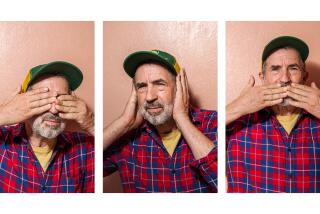Poachers’ Enemy Who Paid the Price
- Share via
I was stunned, but not surprised to learn last month that Dian Fossey had been murdered in her mountain camp near the Visoke Volcano in Rwanda. I had met Fossey in 1975 when I was writing a book about her, Jane Goodall and Birute Galdikas, three women who were then revolutionizing the study of primate behavior by venturing into the forests to meet the wild apes on their own ground. I have since met many other zoologists who are devoting their careers to observing the lives of one species or another.
But Fossey was unlike all the others. Fifty-three when she succumbed to her impatient murderers (impatient because she suffered acute lung problems and did not expect to live much longer), she had trod an irregular path to the Parc de Vulcans on Mt. Karisoke. Thirty years ago young women did not usually think in terms of Ph.D’s in zoology. Rather, those who liked animals toyed with being veterinarians, and often managed to make an impression on the world in some idiosyncratic fashion.
One of the qualities that distinguished Fossey from her colleagues Goodall and Galdikas was her determination from the beginning to be with gorillas. Goodall and Galdikas liked animals and became devoted to their subjects--chimpanzees and orangutans, respectively--after they had been encouraged to focus on those species. But Goodall has also reported on the behavior of the baboons at the Gombe Stream in Tanzania, as well as the wild dogs of the Serengeti. Likewise, Galdikas has encouraged studies of the gibbons that live alongside the orangutan in the Indonesian rain forest. Fossey, however, had had a lifelong ambition to know gorillas. She had borrowed money to get to see them in East Africa when she was working as an occupational therapist in Louisville, Ky., in 1966.
When she learned later that year that Louis Leakey, the paleontologist who had encouraged Goodall’s work with the chimpanzees, was looking for someone to do the same job with mountain gorillas, she persuaded him that she was the person he needed. Only after she had established contact with the gorillas did she heed those who advised her to get both scientific expertise and credentials, which she did at Cambridge University.
Fossey’s relationship with gorillas was intensely personal. For reasons we cannot know, the tall, dark-haired woman felt alienated from most human society. She found instead evidence of family loyalty, affection and kindness among the gorillas whose lives she shadowed as a voyeur. She thought of them as “gentle giants,” which indeed they are, and came to love them.
Unlike Goodall and Galdikas, who have had with them the company of husbands, children and scientific colleagues, Fossey initially worked alone. Even when the Karisoke Research Center expanded to house colleagues and assistants, she kept essentially to herself. It is likely that the emotional support most people find in other people, she found among the gorillas whose lives she chronicled in articles, an autobiography, and on film for the National Geographic Society.
Fossey did not just love the species Gorilla gorilla. She cared for individual animals. Her desire to protect them increased as their numbers dropped from thousands to just a few hundred during the 18 years she spent among them. Their enemy became her enemy. She waged a private war on the part of the gorillas against some of the Africans who lived near the park and made their livings as poachers.
While other scientists sought to include Africans in their projects, Fossey feared that habituating--that is getting the gorillas used to African observers--would compromise their safety; she felt they were better off fearing black human beings altogether.
When Digit, one of her favorite gorillas, was killed by poachers, Fossey seemed to turn some kind of psychological corner. Her colleagues reported that in the years after she returned to the Karisoke Research Center after teaching at Cornell, she devoted her time not to science, but to combatting poachers. She is said to have kidnaped a human child to bargain for the release of an orphaned gorilla, and to have pistol-whipped other poachers. Although she wrote in her biography that the only way to save the park, and the wildlife within it, was to educate the local people about the necessity for keeping the area as a water catchment for the farmers, she seemed more determined on retribution than on education. Yet harsh as her methods became, they certainly did not warrant the violent death she found.
In any event, if the mountain gorillas are to survive, the Rwandese, including the poachers she so enraged, will have to be persuaded that it is in their own economic and spiritual interest to preserve them. In the long run the gorillas’ value lies in their splendid way of living, not in their sale as souvenirs.
It is impossible not to admire Fossey’s achievement, crossing the magical line that divides kindred species, in this instance Homo sapiens and Gorilla gorilla. But her successes may have saved only a little time. She is gone and no one is patrolling the mountain as she once did. Engaged, it seems, in a dark struggle against those whom she perceived as the enemy, she loved not wisely but too well.
More to Read
Sign up for Essential California
The most important California stories and recommendations in your inbox every morning.
You may occasionally receive promotional content from the Los Angeles Times.













